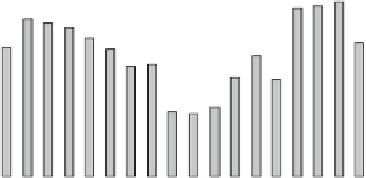Environmental Engineering Reference
In-Depth Information
2500
60
50
2000
40
1500
30
1000
20
500
10
0
0
subsidy
passenger km
Figure 15.2
Rail subsidy and patronage 1980-2005 (see explanatory comments in text)
15.5 Rail passenger service subsidies and fare regulation
As explained in section 5.8 government subsidies to maintain rail passenger services
- and avoid further line closures - were introduced at the end of the 1960s. As a
nationalised industry fare structures were standardised across the network and overall
fare levels determined as a matter of Government policy. PTAs were also able to support
local services and fund higher service levels (and subsidise fares) as part of overall
transport policies in the provincial conurbations. This facility was never available in
London to the former GLC and elements have only recently been introduced in the
refranchising of a group of North London lines (branded as the 'Overground').
Overall the subsidy requirement was linked to fluctuating economic cycles, with
peaks during the recessions of the early 1980s and 90s when passenger levels fell (see
Figure 15.2). In 1995 subsidy leapt by over 70% because of the change in the basis of
accounting for infrastructure costs prior to privatisation. This amounted to a short-
term increase in public expenditure which was planned to be offset in the following
years by a reducing profile of subsidy payments to the train operating companies
(TOCs) awarded the first round of franchises. After 2000 national (GB) liabilities were
also reduced because of the transfer of responsibilities to the devolved administrations.
However the payments to operators give a very misleading impression of the
public cost of maintaining the nation's rail network after 2000. From this time the
Government began to make very large additional payments, directly to Railtrack and
then its successor Network Rail, to support a programme to remedy the backlog of
track maintenance and renewals. Costs within the industry were also rising rapidly.
These included meeting the requirements of the Disability Discrimination Act (for
which no special payment was made), the increasingly stringent - arguably excessive -
standards set by the Health and Safety Executive and the rocketing costs of insurance
and other expenditures associated with the litigation-ridden commercial regime.
Overall by 2006 the national rail network was costing the taxpayer in excess of £5bn.
Forty percent of the DfT's budget was being spent on a mode which served only 8%
of the nation's travel.
The payments to operators remain very heavily skewed towards the former Regional
sector of British Rail. This includes most of the country's rural lines which escaped the
Beeching axe whose financial performance remains dire. For example the short (barely
10 miles) section of railway which continues to operate on the Isle of Wight has annual




















Search WWH ::

Custom Search